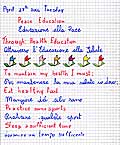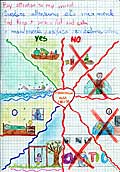|
Integrated TRADITIONAL Medicines OBJECTIVES | PROGRAMME | ORGANISERS | SPEAKERS | Announcement | THE VERBANIA DECLARATION PHOTO | MEDIA | SPONSORS & PATRONS | HOME | SEARCH | WORLD PEACE CONGRESS | SITE MAP
|
|
|
Chiara Ferrari - 4º - Premeno |
Born in Macerata (Italy), she moved to
Holland in 1998. Back in Italy since 1999, lives in Premeno (Province of
Verbania). Ms. Quintili has been an elementary school teacher for over
twenty years; her work also includes teaching adults, senior citizens,
students with specific educational needs and foreign students.
Ms. Quintili writes poetry and has also written ‘Un Dono da Scoprire’ (A Gift to Discover) a short story about inter-religious matters for young children. She attended many professional updating courses and formation courses for teachers offered by the several Italian and foreign educational institutions – mainly concerning the teaching and learning of foreign languages. Furthermore, she is dedicated to inter-cultural and diversity education, religious and spiritual education, peace education and non-formal education. She is also interested in art, philosophy and Oriental religions and cultures and takes part in various initiatives for the actualization of the “Spiritual Forum” and about integration of traditional and alternative medicines. Recently she has been working in two educational-didactical projects: “A peaceful future” last year and “Searching for peace” this year, both inspired by Lama Gangchen’s principles for better living, in order to create a Peace Culture, which may bring hope to future generations, and by his teachings about non violent medicine and inner peace, which is the most solid foundation for world peace.
Didactical Education Project: “Searching for Peace” 2º year - “Peace Education” - “Non-Formal Education for Better Living” - “Health Education” - “World Education through active integration with one’s own environment” Premise It has been proposed by means of a meaningful “teaching-learning” process and the whole of knowledge’s integration, to awaken and arise consciousness in the young learners about diversity, inter-culture, pluri-linguistics, seen as efficient instruments towards a gradual knowledge and building of a Peace Culture. Principles Non-violence is the
true key to free us from using inner and outer violence. Educational Objectives Learning to use
non-violent recreational and communication means (see “the Verbania
Declaration-IAEWP World Congress 2003). Didactic Objectives Create the habit of
trying to recognise, control and transfrom negative thoughts and
attitudes, into more positive and healthy attitudes. “Peace thoughts by famous people” – I selected a collection of carefully chosen phrases, speeches, poetry, prayers, popular saying and songs, in several languages, taking great care to use an approach that is broad in the human sense, as well as non-sectarian as far as politics, religions and social backgrounds are concerned. “The essence of all religions is peace” - Since it is well known and a view shared by many, the concept that, the essence of religions is the search and the maintaining of peace, inside and out, it was almost inevitable that we should chose their words as a testimony to different spiritual beliefs, from an inter-religious, trans-spiritual and lay perspective. “Violent and
non-violent games” – Classification of the two categories. Learning
the cooperative game where we can only win if the other’s needs are taken
into consideration. Working in couples or in groups. Discussions about the
values to be reaffirmed, but also about negative stereotypes to correct or
remove. “Your actions are your own responsibility” – Observation of the surrounding environment, from close and from far. Collective investigations on the causes of our aggressive and mistaken behaviors, which are all the result of violent thought. Discussions to express our own contribution, to become conscious agents for new solutions to our individual and collective problems. “Peace is ... a clean world” – Check how the counterpart of each of our actions produce an effect in our inner and outer environment; become aware that there is a close interdependent relationship between our own well being and environmental balance. We came up with simple but efficient intervention strategies to save our immediate environment and to avoid energy wastes and the waste of environmental and human resources. “My health is the health and well being of everyone” – To become conscious of the responsibility of all individual and social actions around us. To recognize the true friends and enemies of our health. To understand how beneficial it is to avoid useless words, gestures, thoughts, emotions, useless fears and their resulting behaviors. Learning to respect our own body and our own mind, and to identify the close relationship between them. Active listening to the other with a problem-solving attitude. “The aims and functions of the United Nations” – Controlled use of the internet to navigate on sites of the UN and UNICEF, dedicated to young people, through interactive games and cartoon programmes, to discover these organisations without boundaries, and to use different means of non-violent communication, instruction and diversion. Conclusions The students developed some understanding of the interdependence between their own well being and environmental balance; from their familiar world and venturing towards more global and often incomprehensible dimensions, to find out about the crude realities of a world that starves its poor, destroys the weak and gets richer by producing child sized armaments, without however losing sight of our human condition. To find happiness through inner peace - which should become our primary morality - we will have to learn to take care of one another, by always asking ourselves: “What can I do to help those who live around me?” Constantly and gradually widen our healing circle. Moreover, to affirm that the essence of human nature, which we all too often forget, is innately made of love and compassion, even in those who say to be atheists, and which is also evident in all animals. Our essential humanness is obscured, suffocated, weakened; we must recognize it and cultivate it once more, both inside and outside of ourselves. In order to avoid future shocks, such as the news of the 2nd world war then, and the certain and by now irreversible process of self-destruction of the planet at the hands of man, let us learn about and spread Peace Culture in order to preserve the environment and to raise our consciousness to become conscious agents of change of the new world. “Only love can transform en enemy into a friend” Martin Luther King; Man’s problems can only be solved with non-violence” Gandhi; and to remember Mother Teresa of Calcutta, let us learn and teach to humbly give the best of us, without any expectations, so as to become more genuine human beings for the benefit of all living beings. Encourage the increase of self-esteem and the will to learn, as a necessity to reach a higher level of social integration and as a service to the community. What is the real meaning of Self-Healing? To affirm that: I, whose name is …, assume the responsibility to heal myself, to heal this world and its beings, with correct, noble and heroic behavior, in order to pacify myself, my community and the environment in which I live and interact. Just as Mother Teresa’s motto was: “take his hand and never let go of it”, referring to God, so too can we hold the hand of our dearest spiritual friends and walk together in trust, accompanied by the echo of “When the saints go marching in”, without ever forgetting those who still have to join us. |
|
|
|


